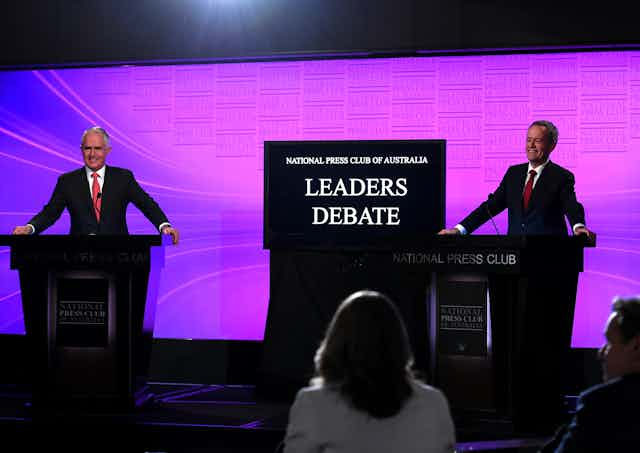We are not convinced that giving the largest banks in Australia $7.4 billion over the next ten years is good for the budget. – Opposition Leader Bill Shorten, leaders’ debate speech, May 29, 2016.
Opposition Leader Bill Shorten’s line of attack during the leaders’ debate focused squarely on the Coalition’s long-term plan to cut the company tax rate from 30% to 25%.
Twice during the debate Shorten said the proposed tax cuts equated to giving A$7.4 billion over ten years to Australia’s big four banks (National Australia Bank, the Commonwealth Bank, ANZ and Westpac).
Is that right?
Checking the source
When asked for a source to support that assertion, a Labor spokeswoman referred The Conversation to modelling conducted by think-tank The Australia Institute.
The Labor spokeswoman said:
Bill was emphasising the clear point of contrast in this election campaign, which is that Malcolm Turnbull wants to spend $50 billion giving huge companies a tax cut while Labor wants to invest in schools, Medicare and growing good jobs.
The Australia Institute modelling
In a press release, The Australia Institute said that for their economic modelling:
The value of company tax provisions was derived from 2015 full year annual reports for the big four banks. That figure summed to $11,123 million. That figure was projected forward to 2026-27 to give the no-change scenario.
To arrive at the figure of $7.4 billion, The Australia Institute modelling assumed bank profit would increase in line with nominal Gross Domestic Product. Under this assumption, the amount of tax payable would also increase in line with nominal GDP. This would give nominal increases of:
2.5% in 2015-16;
4.25% in 2016-17; and
5% in 2017-18 and subsequent years.
As the think tank noted in its press release, the company tax cuts would not affect the big banks until 2024-25. That’s when the 30% company tax rate will fall to 27% for all companies with further reductions of 1% per year, hitting 25% in 2026-27.
The Australia Institute calculated the following results:

A reasonable guesstimate – but not a fact
On these calculations, the “$7.4 billion over the next ten years” claim is not a fact. But it’s also not an unreasonable guesstimate – although it is, of course, really over the three years from 2024-25 through 2026-27. There is no advantage to the big banks over the first seven of the next ten years.
According to the Australian Taxation Office, the four big banks paid a total of $9.5 billion in company tax in the 2013-14 financial year.
The government has proposed increasing the turnover threshold below which the rate of company tax payable is 27.5%, from $10 million in 2016-17 to $1 billion in 2022-23.
The government’s proposed policy says that the company tax rate for all companies (including the four big banks) with turnover exceeding $1 billion will fall from 30% to 27% in 2024-25, and then by a further one percentage point in 2025-26 and another percentage point (to 25%) in 2026-27.
So, on that basis, The Australia Institute’s maths checks out.
A grain of salt
As with all economic modelling, this modelling and any claims based on it should be taken with a large grain of salt.
Any assumption about the banks’ profit growth over the next ten years is entirely arbitrary, and I have no idea whether it is at all justified. Only time will tell.
If the banks’ profits grew by only 2% per annum over this period, then the benefit to them from the cut in the company tax rate proposed by the Coalition would be “only” $4.8 billion; if they grew by 10% per annum the benefit to them would be $12 billion (over the three years from 2024-25 to 2026-27).
Verdict
Shorten’s statement relies on modelling assumptions made by The Australia Institute think-tank about bank profit growth. It is not a statement of fact but rather a guesstimate. It is not an unreasonable guesstimate, but depends entirely on whether the think tank’s assumptions about bank profit growth come true or not. – Saul Eslake
Review
This article correctly reflects the analysis of The Australia Institute upon which the claim of a “windfall” for the large banks has been based. As the author notes, the baseline figure is a guesstimate based on not unreasonable assumptions about the growth of the economy and the impact of the proposed business tax cuts upon bank profits, albeit seven years out. – Pat McConnell

